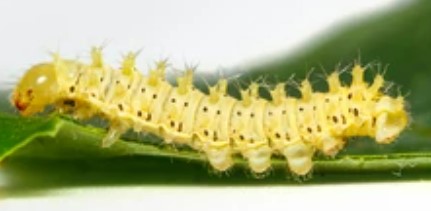
Philosamia cynthia ricini is a subspecies of the giant silkworm moth, and is one of the important silkworm species for silk production. It was originally a wild silkworm growing in the wild, feeding on Castor leaves, Cassava leaves, Cranewood leaves, Ailanthus leaves and Cypress leaves. It has medicinal properties and is used to treat rheumatic arthralgia and unfavorable joints. It is a highly adaptable polyphagous silkworm. Now it is grown in the wild, stocked by artificial stocking, and also indoors by artificial stocking. After the cocoon is refined, it becomes an excellent industrial raw material for silk spinning.
Philosamia cynthia ricini goes through four developmental stages: egg, larva, pupa and adult in one generation. At present, it is the most advanced method to improve the genetic traits of philosamia cynthia ricini through gene editing, which is of great significance to the study of philosamia cynthia ricini, and thus to improve the resource utilization of philosamia cynthia ricini. Lifeasible provides gene editing services for philosamia cynthia ricini with zinc-finger nucleases (ZFNs), transcription activator-like effector nucleases (TALEN) and CRISPR/Cas9 to optimize genetic traits of philosamia cynthia ricini.
| Editable genes | Relevant traits exhibited after editing |
| ScFerHCH ScFerLCH |
|
| PcrHE |
|
| Pcrace1 |
|
| AGO1 |
|
| JHAMT Samcri-AT |
|
Lifeasible provides gene editing services for philosamia cynthia ricini by ZFNs, TALEN and CRISPR/Cas9 to affect the immune system, the process of reproductive, the growth and development, and other biological functions of philosamia cynthia ricini. If you are interested in our services or if you have any questions, please click online inquiry for more detailed information.